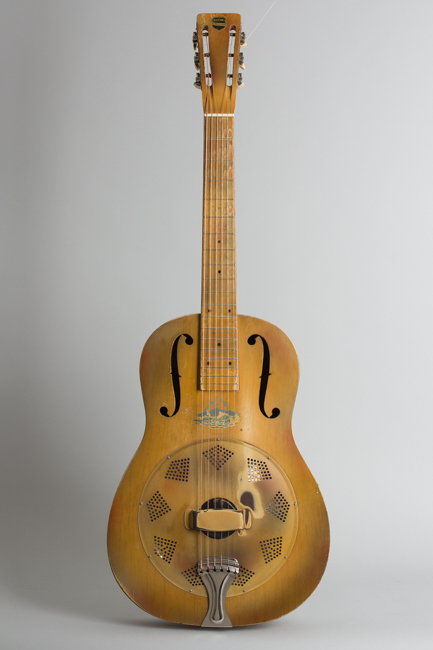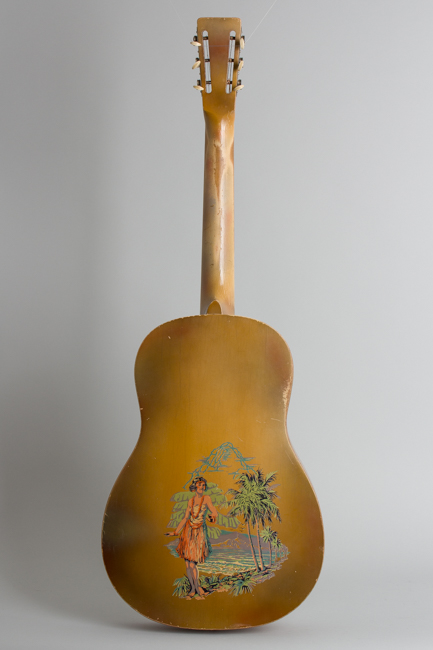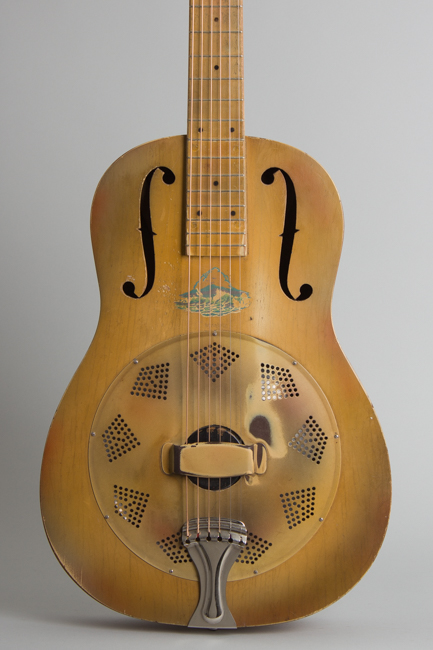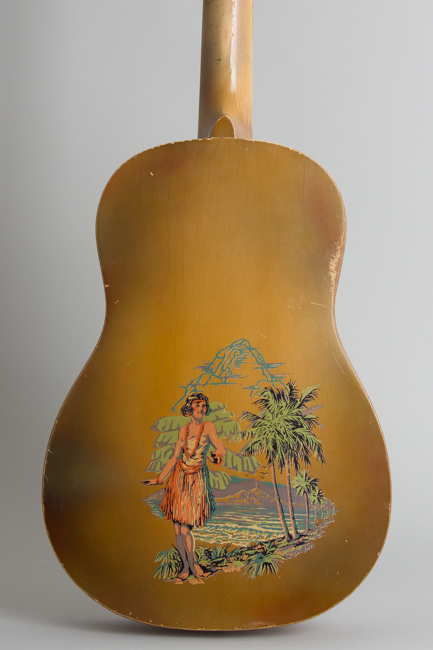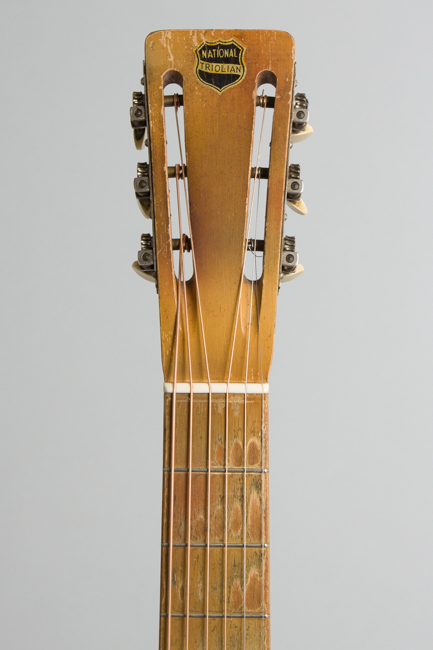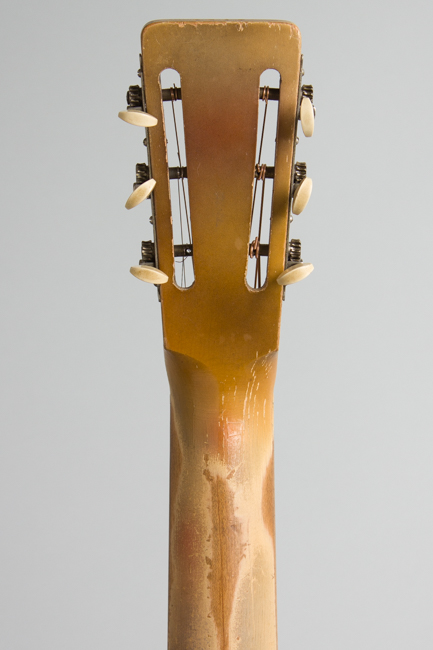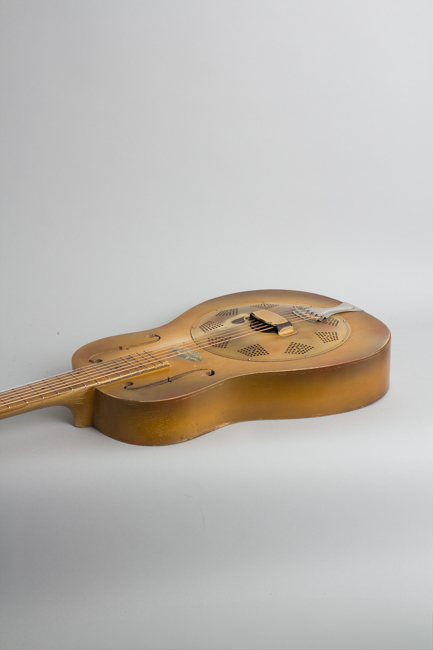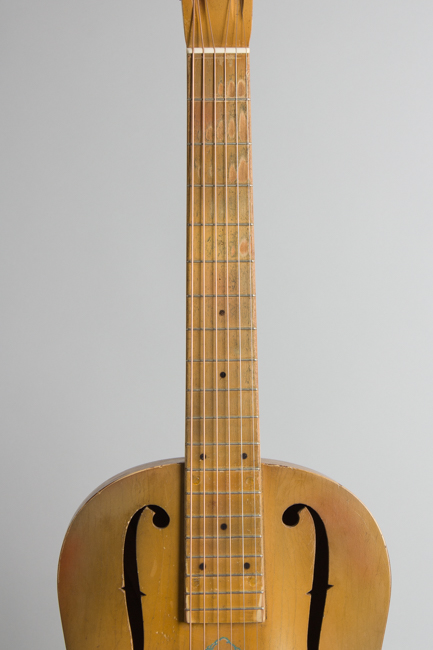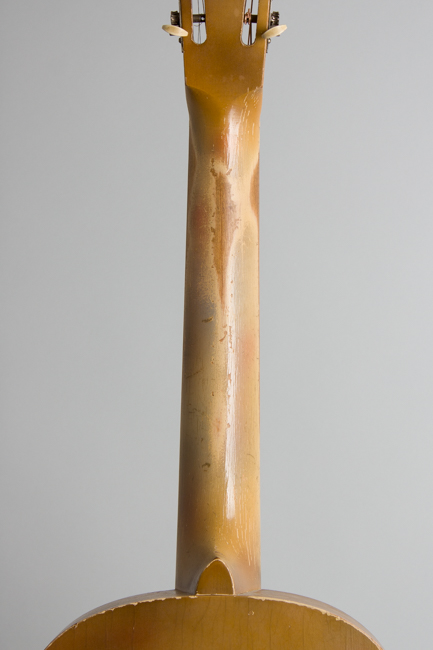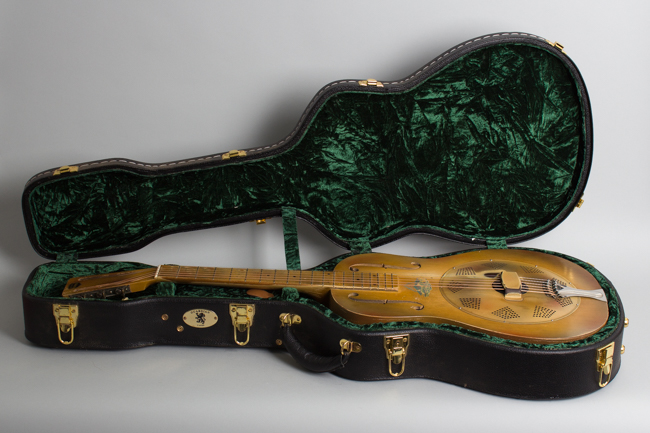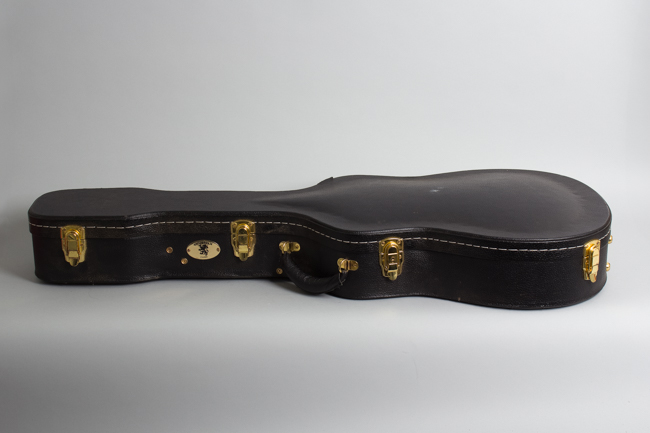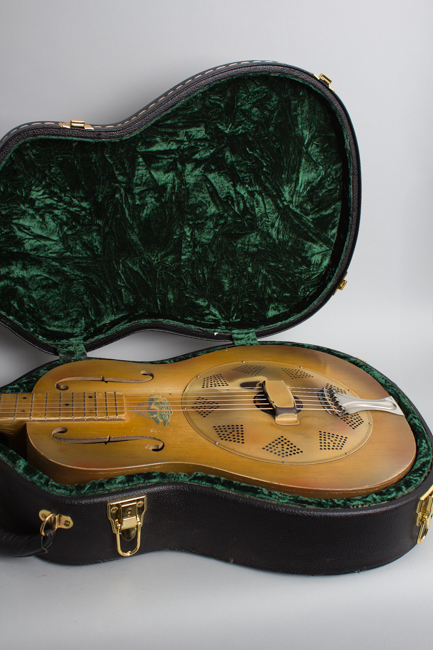National Triolian Resophonic Guitar (1929)
This item has been sold.
Item # 12489
Prices subject to change without notice.
National Triolian Model Resophonic Guitar (1929), made in Los Angeles, serial # 1047, Polychrome enamel with stenciling finish, laminated wood body, basswood neck, black tolex hard shell case.
This rare Triolian is from the first series of single-cone National Resophonic guitars made, designed just before the Great Depression made lower-priced instruments a necessity. This wooden-body version of the Triolian was only available for only a brief period, introduced around the end of 1928 and discontinued in the last quarter of 1929. National first tried a triple-cone version of this wood-body instrument (hence the name "Triolian"), but quickly found the concept of a budget Tricone uneconomical. The single cone design was easier and cheaper to make, but as National was more equipped to work with metal than wood, a stamped steel body was soon adopted as a more efficient production expediency. This original wood-body version was quickly replaced by the much more common metal body Triolian, built in the thousands through the 1930's.
There are many differences between this early Triolian and the later common models. This guitar's twelve fret basswood neck has an unbound, painted fingerboard with stenciled black dot inlay. The laminated wooden body is painted yellow with very subtle airbrushed red and blue highlights. The words "PAT APP FOR" are stamped directly on top just above resonator cover. There is a beautiful full-color stencil of dancing hula girl on back and an ocean wave on front, both unique to this model. The tuners are the same fairly fancy engraved-plate Waverly strips used on the Tricones of the period.
The single cone guitars that descended from this first model ensured the National company's survival during the Depression, being far less expensive to produce than the elaborate Tricone that had previously been their sole product. This style Triolian is historically significant, representative of both the earliest commercial single-cone guitar and the first wooden body resonator instrument. It is also a wonderful and unique sounding guitar, with a deep and surprisingly sweet sound quite unlike its steel-bodied brothers in both feel and tone. Like them it is an excellent instrument for delta blues and slide playing, but has a warmer character well suited to other styles as well.
Overall length is 39 in. (99.1 cm.), 14 in. (35.6 cm.) wide at lower bout, and 3 3/8 in. (8.6 cm.) in depth at side, taken at the end block. Scale length is 25 in. (635 mm.). Width of nut is 1 7/8 in. (48 mm.).
This Triolian is generally well preserved overall, nicely original showing signs of use over the last 95 years. The somewhat fragile painted finish in better condition than many, looking a bit darkened and "smoked" overall. It shows checking, chips and dings but the heaviest wear is to the body edges. The back of the neck is worn to the wood in the lower positions and on both sides of the fingerboard, while the painted fingerboard shows play wear up to the fifth fret and down at the strumming end. The finish on the steel coverplate and handrest has darkened somewhat with some rubbed away areas, but none of the wholesale flaking off common with these early models. The colorful body stencils remain in excellent shape and look great; many if these have flaked badly by now. The headstock decal is a later repro in the correct style.
All hardware appears original including the cone and biscuit, tailpiece, and tuners. The plating is a bit corroded on the tailpiece. This guitar has had a neck reset and is in fine playing condition. The finish patching to the covered screws at fingerboard end over the body is visible, but this is difficult paint to match exactly and it is not distracting. The frets appear original, likely crowned down a bit showing minimal subsequent wear. This is a very nice-playing example of this rare and rather historic National, definitely blues-approved but it sounds lovely for just about anything. Overall Very Good + Condition.
This rare Triolian is from the first series of single-cone National Resophonic guitars made, designed just before the Great Depression made lower-priced instruments a necessity. This wooden-body version of the Triolian was only available for only a brief period, introduced around the end of 1928 and discontinued in the last quarter of 1929. National first tried a triple-cone version of this wood-body instrument (hence the name "Triolian"), but quickly found the concept of a budget Tricone uneconomical. The single cone design was easier and cheaper to make, but as National was more equipped to work with metal than wood, a stamped steel body was soon adopted as a more efficient production expediency. This original wood-body version was quickly replaced by the much more common metal body Triolian, built in the thousands through the 1930's.
There are many differences between this early Triolian and the later common models. This guitar's twelve fret basswood neck has an unbound, painted fingerboard with stenciled black dot inlay. The laminated wooden body is painted yellow with very subtle airbrushed red and blue highlights. The words "PAT APP FOR" are stamped directly on top just above resonator cover. There is a beautiful full-color stencil of dancing hula girl on back and an ocean wave on front, both unique to this model. The tuners are the same fairly fancy engraved-plate Waverly strips used on the Tricones of the period.
The single cone guitars that descended from this first model ensured the National company's survival during the Depression, being far less expensive to produce than the elaborate Tricone that had previously been their sole product. This style Triolian is historically significant, representative of both the earliest commercial single-cone guitar and the first wooden body resonator instrument. It is also a wonderful and unique sounding guitar, with a deep and surprisingly sweet sound quite unlike its steel-bodied brothers in both feel and tone. Like them it is an excellent instrument for delta blues and slide playing, but has a warmer character well suited to other styles as well.
Overall length is 39 in. (99.1 cm.), 14 in. (35.6 cm.) wide at lower bout, and 3 3/8 in. (8.6 cm.) in depth at side, taken at the end block. Scale length is 25 in. (635 mm.). Width of nut is 1 7/8 in. (48 mm.).
This Triolian is generally well preserved overall, nicely original showing signs of use over the last 95 years. The somewhat fragile painted finish in better condition than many, looking a bit darkened and "smoked" overall. It shows checking, chips and dings but the heaviest wear is to the body edges. The back of the neck is worn to the wood in the lower positions and on both sides of the fingerboard, while the painted fingerboard shows play wear up to the fifth fret and down at the strumming end. The finish on the steel coverplate and handrest has darkened somewhat with some rubbed away areas, but none of the wholesale flaking off common with these early models. The colorful body stencils remain in excellent shape and look great; many if these have flaked badly by now. The headstock decal is a later repro in the correct style.
All hardware appears original including the cone and biscuit, tailpiece, and tuners. The plating is a bit corroded on the tailpiece. This guitar has had a neck reset and is in fine playing condition. The finish patching to the covered screws at fingerboard end over the body is visible, but this is difficult paint to match exactly and it is not distracting. The frets appear original, likely crowned down a bit showing minimal subsequent wear. This is a very nice-playing example of this rare and rather historic National, definitely blues-approved but it sounds lovely for just about anything. Overall Very Good + Condition.
